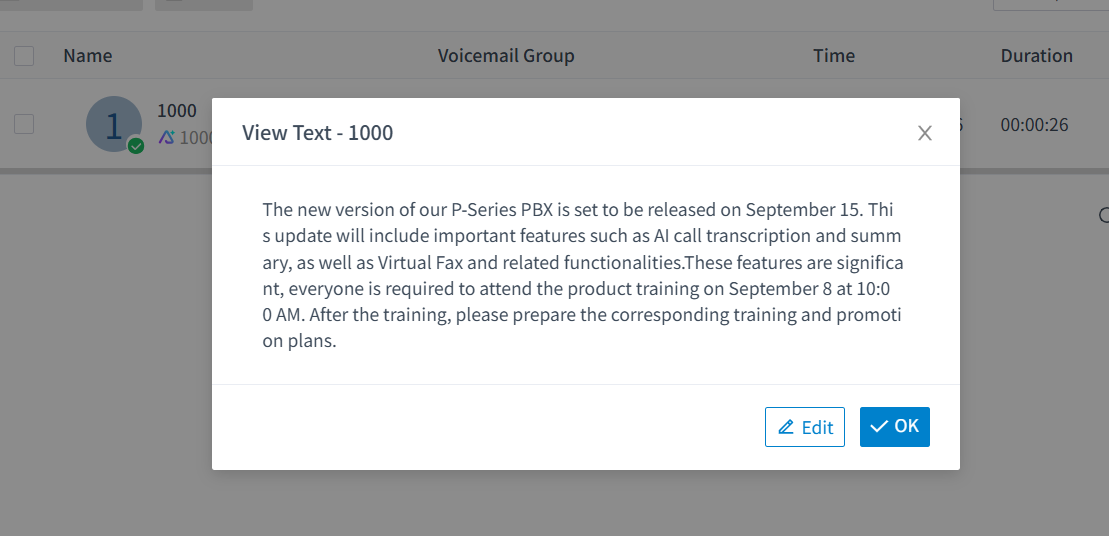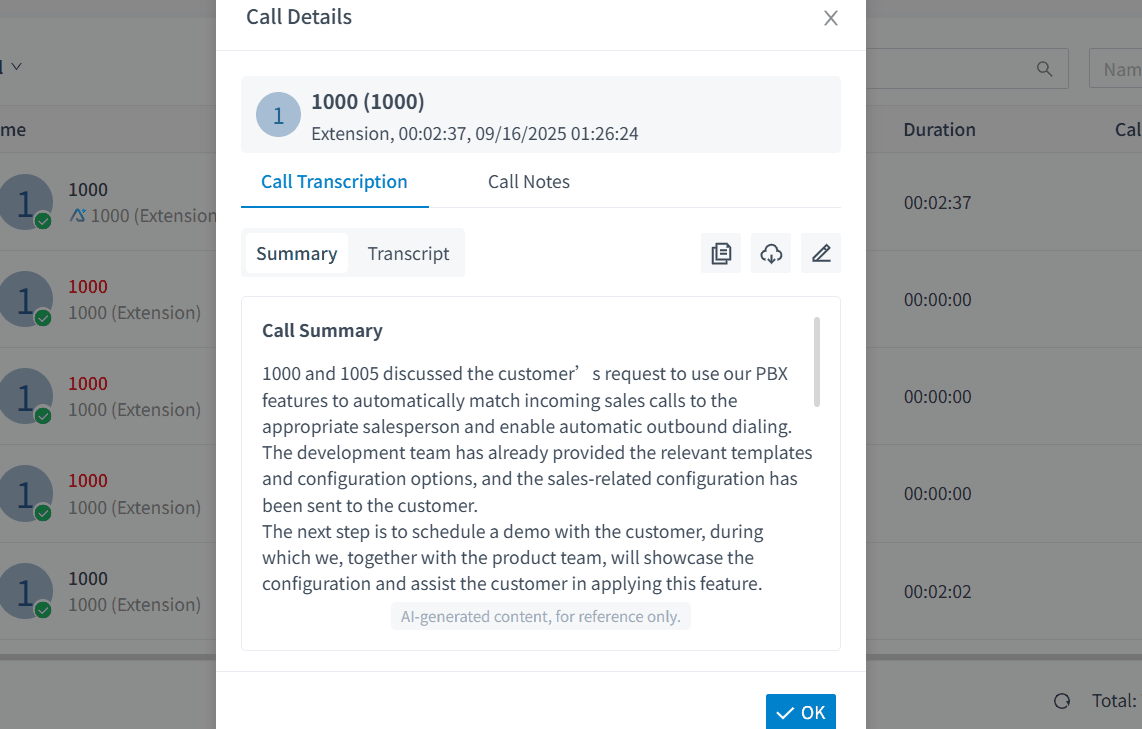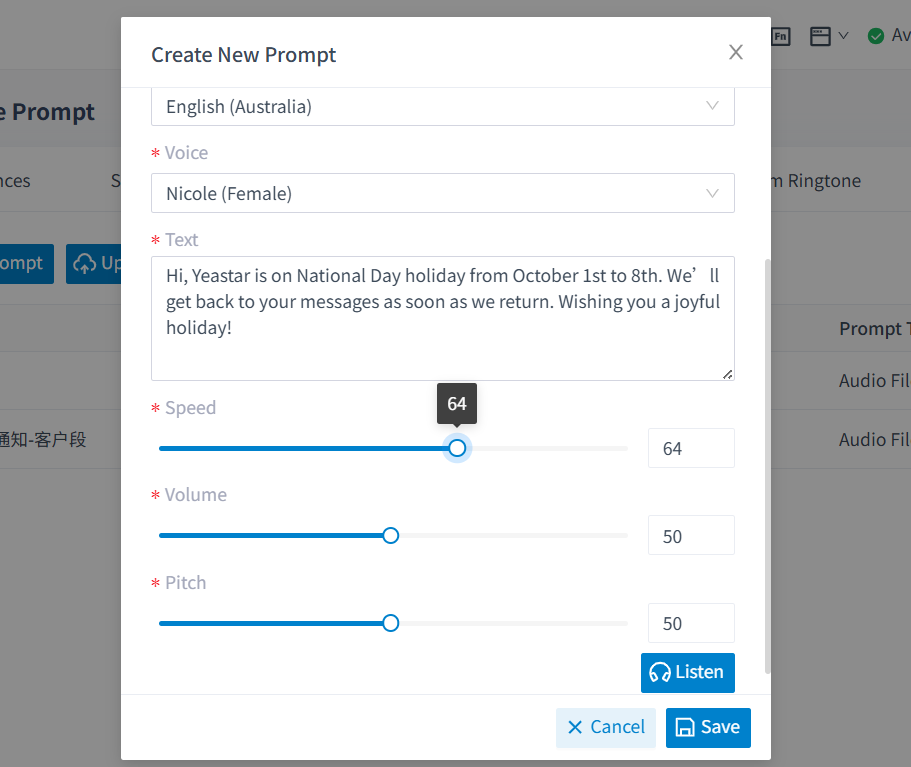
This July, we embedded AI capabilities into the Yeastar P-Series PBX , including Voicemail Transcription, Call Transcription& Summary, Text-to-Speech, and WebSocket for Audio Streams Transmission. Naturally, the big question for us was:
“Is bringing AI into PBX more hype than real value? So far, it doesn’t seem to have disrupted the industry.”
Instead of making assumptions, we decided to find out through real use. We invited six colleagues from different roles to try these AI features for the very first time in a simple “blind test,” experiencing them just as everyday users would.
Our goal was clear: to see how these features perform in real work scenarios, whether they deliver practical value, unexpected surprises, or even frustrations.
Here’s what we discovered.
Catch Every Part of This Blog
- First Impressions: Cautious and Practical→
- The Test: Three Everyday Scenarios→
- Finding the Truth and Moving Forward with AI→
- AI Roadmap for Yeastar P-Series PBX →
First Impressions: Cautious and Practical
Before the test, we recorded testers’ initial impressions of AI in PBX. Understanding these expectations was interesting, it gave us a baseline to see whether the actual experience would confirm or challenge their assumptions.
“I rely on AI a lot, but PBX + AI? If it could automatically route calls or turn them into text, that would really help me follow up with leads.”

Summer
Sales Operation, A heavy caller
“Sounds cool, but feels a bit standard. It’s new, so I understand. I just hope it’s not too complicated.”

Zoe
Marketing, A information handler
“STT and TTS are common now. Accuracy is the key. And if it only supports one language, it won’t matter much for global use.”

Kay
Sales Operation, A pragmatist
Most expectations were pragmatic, but little skeptical: “Will it be accurate?” “Is it really useful?” “Will it be complicated to use?”
The Test: Three Everyday Scenarios
With those questions in mind, we set up three typical office scenarios. Let’s see how the AI features in P-Series PBX performed.
Voicemail Transcription
Test Scenario: Use the transcription tool to handle a long voicemail about product training.
We got feedback from the testers.
- Nichole (Training Instructor):
“Fast response. I just click a button, and the text appears. I can even edit it. That makes organizing messages much easier.”
- Zoe (Marketing):
“Accuracy is high, even when the audio was a bit unclear but still around 95%. And being able to edit the transcript is very handy.”
She also noted:
“But it’s just plain text. If it could skip filler words like ‘um’ and highlight key points or add a summary, that would be even better.”

Conclusion
Before the test, testers were concerned about the accuracy of this feature. However, they were pleasantly surprised by how well it performed. Even when the audio was slightly unclear, voicemail transcriptions were delivered in just a few seconds with over 95% accuracy, addressing Zoe’s initial concerns. They also appreciated the ease of use and the ability to edit transcripts directly, which makes organizing messages much more efficient.
At the same time, testers suggested ways to make the feature even smarter, such as skipping filler words, highlighting key points, or generating summaries. We see this as a clear reflection of real user needs and a key direction for our next steps in enhancing the AI transcription experience.
Call Transcription & Summary
Test Scenario: A call with customer to discuss the technical issues. Review a long and complex call about technical issues.
We got feedback from the testers.
- Summer (Sales Operation):
“This is really helpful! I’d like it for the whole team. Now I don’t have to split focus between listening and note-taking. I can just talk with the client, and by the end, I already have a transcript and a clear summary.”
- Mandel (Training Instructor):
“It’s more than just text, it’s a ready-made training resource. The transcription runs quickly; as long as someone is speaking, the text keeps up, and by the time the call ends, the transcript is basically done too. Right now it seems to handle one-to-one conversations well, but for group discussions, having the same transcription capability would be very useful. And if it could also connect with CRM to generate follow-up actions, that would make it even more powerful.”

Conclusion:
Test results of this feature went far beyond our expectations. Both testers immediately recognized the real value of Call Transcription & Summary and so did we. In fact, we didn’t wait. Right after the test, we rolled this feature out to our internal sales team, because it directly tackles one of the biggest challenges in communication: balancing the conversation itself with accurate record-keeping and actionable follow-ups.
Instead of splitting attention between talking and note-taking, users can now fully focus on the client, confident that every word is captured and a concise summary is ready afterward. The speaker-based transcription stood out as another highlight, making it simple to revisit details, double-check key points, and ensure nothing is missed.
What makes this feature truly valuable is not just the technology, but how it transforms a daily struggle into a seamless flow: communicate clearly, capture accurately, and insight effectively. That’s why our testers and our own teams see it as more than a convenience, but as a must-have tool.
And the story doesn’t stop here. Feedback like automatic transcription in multiple languages, multi-party meeting support, and CRM integration has already shaped our next steps. These expectations keep driving us to refine the feature and deliver even greater value for real-world work.
Text-to-Speech
Test Scenario: Quickly create a multilingual holiday announcement for National Day.
We got feedback from the testers.
- Yuki (Marketing):
“It saves so much effort. We can instantly generate consistent voice messages in multiple languages, no more arranging recordings.”
- Kay (Sales Opeartion):
“The voice is realistic, and being able to choose the target language is great! The default voice feels a bit formal, which works well for official announcements. However, since much of my work involves speaking with customers, I prefer the more voices they sound more lively and engaging. Also, it could be better if there were more male voice options, and I’d like more choices to match different customer groups.”

Conclusion:
In the test, our testers could generate multilingual announcements and prompts within seconds, making it easy to handle scenarios like holiday greetings, inbound call messages, even used in automated callflows. Both of our testers agreed that the feature saves significant time than ever before.
At the same time, Kay highlighted the need for richer, more engaging voices for customer-facing interactions, as well as more voice options to match different audiences. This reflects a broader expectation for Text-to-Speech to go beyond convenience and deliver variety, emotion, and adaptability.
That’s exactly where we’re heading next. In our next release, our P-Series PBX will introduce Neural Text-to-Speech, bringing voices that are more natural, expressive, and engaging.
WebSocket for Audio Streams Transmission
Beyond embedding AI features directly into the PBX, we also recognize the broader value AI can bring to communications. That’s why we’ve enabled WebSocket for audio stream transmission, making the PBX compatible with external AI platforms for tasks like speech analytics, voice security analysis, and more.
While this wasn’t part of our blind test, it reflects our goal of opening up AI capabilities and giving users the flexibility to integrate PBX with a wider range of intelligent tools for better call management.
*Try It Out: Want to see these functions for yourself? Just enable Integration > AI in your PBX system.
Finding the Truth and Moving Forward with AI
Looking back at all the feedback, the value of AI features in our PBX system can no longer be answered with a simple “yes” or “no.” Through the tests, we’ve experienced firsthand how convenient these features already are in daily work, while also feeling the excitement for the potential changes AI can bring to PBX.
- AI features in our PBX already address concrete challenges like transcription, prompt recording, saving time and reducing errors.
- And it shifts how we work, from “listening while jotting down notes” to “fully listening,” from “manual recording” to “batch generation.” These unexpected changes are the pleasant surprises it brings.
- The most important is that it opens the door to the future. It fuels strong anticipation for what’s ahead—smarter call strategies, deeper integration with other systems, intelligent insights, and automated actions that could transform the way we communicate.
So, is AI in Yeastar PBX more hype than value?
From what we’ve seen, the answer is clear: the value is already here, and the potential is far greater. We see AI not as a slogan, but as a practical force that enhances communication efficiency today and will drive even greater transformation tomorrow. This is just the beginning, and we’re committed to continuously bringing high-value AI technologies into our PBX to unlock more possibilities for the future.
AI Roadmap for Yeastar P-Series PBX
We’re adding more AI power to our PBX, and here’s a sneak peek at what’s next.
The AI Receptionist is already in the planning stage and will be showcased at Yeastar Day 2025 Virtual.
We’re also exploring additional AI capabilities, such as AI sentiment analysis, AI chatbots, call quality report and more. so stay tuned to our product blog for the latest updates.
At Yeastar Day 2025 Virtual, we’ll be focusing on AI and next-generation contact centers, areas that are set to make a significant impact on business communications. Join the live stream on Oct 22, 2025 with us to explore Yeastar’s latest innovations and get a chance to win exciting prizes!
Related Resource
Configuration Guide
- Voicemail Transcription
- Text-to-Speech
- Call Transcription & Summary
- WebSocket for Audio Streams Transmission
Demo Video

